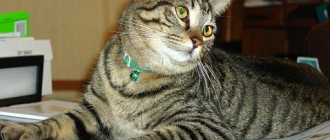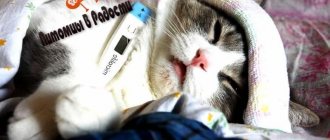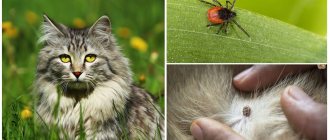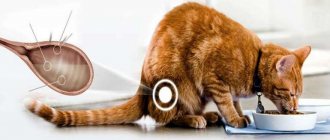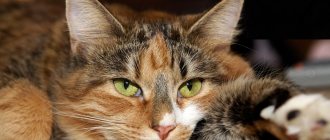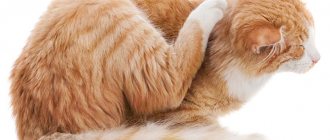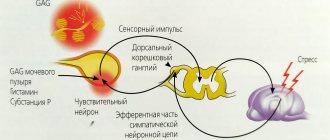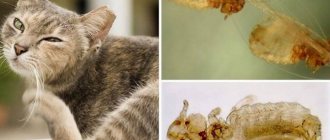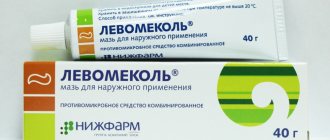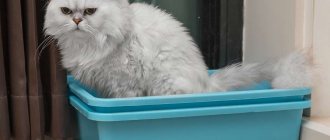Urolithiasis in cats, or urolithiasis, is a disease characterized by the formation of sand or stones in the bladder. One out of four pets is at risk of developing this disease, therefore, owners of furry pets need to know everything about this pathology in order to prevent it in time, and if it occurs, then help the cat at the initial stage, avoiding death.
If the disease is not diagnosed in time, the cat may die very quickly, so if you suspect the development of KSD, you should immediately visit a veterinarian.
Features of the disease
KSD is a chronic pathology: the animal develops salt deposits in the form of stones or sand in the kidneys, urinary ducts, and bladder. Every fourth individual is at risk of experiencing these symptoms. Animals from two to six years old, cats with impressive weight, breeds with long hair, castrated males and unsterilized females are susceptible to the disease.
Manifestations
Males experience the pain of passing stones or sand more often, since their urethra is much narrower than that of females. Periods of exacerbation include the beginning of autumn, as well as the time from January to April.
At first, the disease is not noticed because it does not manifest itself. However, further formations will only increase in size, and one day a moment will come when the formation will move away from the wall of the bladder or kidney and begin to move with the flow of secretions.
Even the smallest formation causes extreme pain to the cat, causing mechanical damage to the delicate surface of the urethra. Impressive-sized salt formations can clog the urinary duct - this is called obstruction. The fluid stagnates, burning pain and intoxication appear. In this case, prompt emergency assistance must be provided, otherwise the animal will simply die.
Types of formations
ICD manifests itself in two types of formations: struvite and oxalate. For the first, an alkaline environment is needed - if there is an excess of phosphorus and magnesium in the body, then the urine becomes alkaline. Struvite has a harder structure.
Oxalates are formed if the urine pH is very acidic. It is caused by high amounts of calcium. Oxalates are special in that they have sharp edges and a loose structure.
Therapeutic nutrition for urolithiasis
The only treatment method that does not threaten the life of the animal is the dissolution of uroliths using a therapeutic diet. This method is applicable only for struvite, urate and cystine and can be done at home.
In addition, the use of medicated feed to a certain extent reduces the risk of the appearance of both struvite and oxalates.
Depending on the urine test, a diet is prescribed. There are 2 types of food in the form of canned food and dry granules for struvite and oxalate type of disease. The therapeutic diet is available from such brands as Hill's (SD), Royal Canin's (SO), Purina (UR).
Medicinal feeds have the following effects:
- acidify the urine (to pH 6.0), which causes the dissolution of struvite;
- increase the secretion of urine, which promotes the removal of salts.
The proportion of magnesium, phosphorus and calcium in medicinal feeds is reduced. But they may contain salt to make you thirsty. Therefore, if salt is contraindicated for your pet (heart failure, kidney failure, heart disease), such a diet is not acceptable.
If the diet is followed correctly, struvite dissolves in an average of 1 month. During the entire period of therapeutic nutrition, monitoring is carried out using x-rays. Therefore, when uroliths are detected, but there is no information about their type, a trial of specialized food is prescribed. In this case, any other products, nutritional supplements, or treats are excluded. If the condition is not complicated by infection, then the diet leads to improvement already on the 5th day.
The animal has a chance to fully recover if within 3-4 weeks the uroliths have become smaller or dissolved.
After effective completion of treatment, the owner must conduct a urine test every six months, ideally once every 3 months.
It is not recommended to feed young cats (under 1 year) with medicated food. If a kitten gets sick, then surgery is considered the best option.
Oxalates cannot be dissolved by diet. Medicinal foods, for example, Hill's (XD), Eucanuba Oxalat Urinary Formula can only act as prevention.
When eating natural foods, you should follow these recommendations:
- food should be as hydrated as possible;
- avoid overfeeding;
- provide soft water for drinking;
- The menu should include a balance of calcium and phosphorus.
If a cat is on homemade food and cannot or does not want to eat commercial medicinal food, there are special additives that acidify urine.
The goal of any diet is to make the urine acidic (pH 6.0). Only in this case conditions are created that are unfavorable for the activity of bacteria and the formation of stones.
Causes of ICD
It is difficult to identify the main and only source: usually veterinarians determine a combination of factors contributing to the onset of the disease. Exogenous (caused from outside) causes include:
- Poor nutrition
. There are various options here: poor or cheap food, low fluid intake, poor drinking water, excessive consumption of minerals, fish and fatty foods, overfeeding the animal. All this disrupts metabolism and changes the pH of urine. A favorable environment is created for the formation of sand and rocky formations.
- Climatic features
. If the air temperature is high, the discharge becomes much more concentrated than under normal conditions. Water with a lot of salts in this case becomes a secondary cause of this condition.
- Vitamin A deficiency
. This element has a beneficial effect on the cells of the mucous membrane of the genitourinary system, and its absence significantly weakens the resistance and regeneration of organs.
But even a well-groomed cat with a balanced diet and favorable living conditions can develop urolithiasis. It is often caused by endogenous (internal) factors, which include:
- Hormonal disorders.
- The presence of chronic diseases, foci of inflammation, congenital pathologies in the development of the genitourinary system.
- Individual anatomy of the animal: for example, a very thin, long or curved urethra.
- Interruptions in the gastrointestinal tract. The acid-base balance will be disturbed, resulting in illness.
- Various infections and complications after them.
- Genetic predisposition: ICD can be passed on from generation to generation. Any unfavorable conditions will promptly start the process.
- A sedentary lifestyle that causes obesity.
Problems with kidney and urinary stones are quite common, and it is impossible to completely protect against them. But if you carefully care for your cat and feed it properly, the risk of disease is significantly reduced.
Who is at risk for urolithiasis?
All members of the cat family, without exception, are susceptible to this disease. However, there is a group of animals in which urolithiasis is detected much more often. To protect your pet from this dangerous pathology, every cat owner should know the reasons that provoke its development and the degree of predisposition of the four-legged pet to the disease. Information about this is presented in the table:
| Causes of urolithiasis in cats | Animals at risk for urolithiasis | |
| External |
|
|
| Domestic |
| |
Symptoms of the disease by stages
When the disease just begins to develop, it is very difficult to notice. Symptoms at the primary stage are not clearly expressed, so the owner does not pay attention to minor changes in the cat’s behavior. The furry friend becomes apathetic, does not want to be active, eats poorly, and experiences discomfort when going to the toilet.
Sometimes owners learn about a dangerous pathology when drastic measures are required. When solid formations form, the main symptoms can already be clearly seen. Their intensity is divided into three degrees:
1. Initial stage.
The cat takes a long time to go to the toilet, and it will relieve itself in a variety of places - psychologically, the litter box begins to symbolize pain and discomfort. The posture when urinating becomes unusual, the animal becomes very tense. After visiting the tray, your furry friend will lick under the tail for a long time and thoroughly. Little urine is produced and may have a pinkish tint. Sometimes grains of sand are visible in it. The urge to go to the toilet becomes frequent. A cat on a tray often meows due to pain.
2. Acute stage.
The urge to go to the toilet becomes frequent. It happens that the animal experiences incontinence: the four-legged friend will leave wet spots in the resting place, and the owners also notice droplets in his crotch. The stomach becomes denser. Blood is already clearly visible in the discharge. Urine is released drop by drop and has a dark color with a concentrated odor. The pet's condition will be very depressed and lethargic. He usually loses a lot of weight, loses his appetite, and does not play with his favorite toys. Body temperature in some cases rises to 40 ˚С. As the stones move through the urinary canal, the cat will meow restlessly and take a characteristic position to relieve the pain.
3. Critical stage.
Your pet may completely stop going to the litter box. At the same time, painful urges will persist. The discharge will stagnate, causing intoxication of the body - often causing vomiting. Your furry friend will be constantly shaking. In the corners of the mouth you can notice accumulated saliva, viscous and foamy. The stomach will become painful and the cat will almost stop moving. If there is no urination, then after 24-36 hours the reabsorption of waste products begins. Body temperature drops slightly. There are convulsions and loss of consciousness.
It is especially important to see a doctor in the last stage. This condition is considered critical and dangerous for the animal. At this time, minutes count – you can save your pet’s life only by quickly delivering him to a veterinary clinic.
Symptoms
It is quite difficult to diagnose the disease when a pet just begins to have urolithiasis. Symptoms in cats at the primary stage are hardly noticeable to the owner. The animal simply becomes lethargic, shows less activity, eats worse and feels discomfort when urinating - these signs cannot always be compared with ICD. During this period, only a urine test will help recognize the disease.
The number and size of formations are increasing. They eventually begin to move, so they can partially or completely block the urinary duct. At this stage, the pet can easily be diagnosed with urolithiasis. Symptoms in cats or cats are obvious:
- due to acute pain during urination (dysuria), the animal meows on the tray;
- often runs to the toilet because he feels a constant urge (pollakiuria);
- the litter in the tray has reddish-pinkish tints instead of yellowish due to the presence of blood particles in the urine (hematuria);
- a complete cessation of urination is possible - the animal strains to no avail, and sometimes cases of rectal prolapse occur;
- upon palpation, you can feel that the abdomen has become tight and painful;
- urination in an inappropriate place, uncharacteristic for a well-mannered pet;
- signs of urolithiasis in cats also appear in behavior: the furry friend behaves persistently and fussily, trying to attract the attention of the owner, or, conversely, hides in a corner and cannot jump to a height;
- loss of appetite, rapid breathing.
Diagnostics: how to identify pathology
It is important to quickly identify the problem so that you can deal with it and save the life and health of your four-legged friend. To do this, at the slightest suspicion of genitourinary problems, you need to take your pet to a veterinary clinic. The specialist will ask you to describe the cat’s behavior in detail, and then prescribe the necessary studies.
Unfavorable changes can be identified using x-rays, ultrasound, and also by studying the sediment of the discharge in the laboratory and determining the type of salt formation. The composition of the crystal will allow you to understand what kind of prevention and therapy needs to be carried out. The clear presence of salts is determined by qualitative analysis methods: light microscopy, Xray diffraction, etc. The specialist will also prescribe a blood test.
At the appointment, you need to accurately and in detail tell about all the details of keeping the pet, its physical condition, diseases, when the first signs of deviations began to be observed, etc.
Preventive actions
With the help of timely prevention, it is possible to prevent urolithiasis in a cat predisposed to this pathology. To prevent your pet from getting sick, you must adhere to the following rules:
- firstly, the cat owner must monitor the pet’s weight and prevent obesity;
- secondly, the owner must ensure that the pet always has fresh water and drinks enough of it;
- thirdly, a castrated or sterilized cat must have a special diet selected by a veterinarian.
In addition, the owner must monitor the normal functioning of the animal’s gastrointestinal tract. The owner also needs to maintain optimal temperatures in the room where the animal is located.
Urolithiasis in cats is prevented using a specially designed diet or by feeding the animal preventive food.
Cat food for the prevention of urolithiasis is produced by the following brands:
- hills;
- royal cannin;
- club 4 paws;
- cat chao;
- brekis;
- pet time.
You should feed your cat only premium or super class food. At the same time, the main thing is to avoid low-quality feed that belongs to the economy class.
Conclusion
Urolithiasis is an extremely dangerous disease for animals, which, if not treated promptly, can cause serious consequences. At the initial stage, only a veterinarian can identify the pathology. Therefore, in order not to lose your pet at the slightest suspicion of urolithiasis, you should contact a veterinary clinic for diagnosis and selection of the correct therapeutic technique that will eliminate the disease and avoid complications.
Treatment of urolithiasis
In a veterinary hospital, the elimination of urolithiasis will begin with ensuring patency of the urinary tract. All interventions are carried out under the influence of painkillers or anesthetics. A catheter is used to clean out sand and remove hard structures. After the procedure, the lumen of the urethra is thoroughly washed with a special antiseptic solution.
Treatment is selected individually, based on the degree of neglect of the disease, age, gender, and well-being of the pet. Conservative methods include dissolving stones and eliminating sand with the help of proper nutrition and special diets that increase diuresis. Along with this, antispasmodics and painkillers are used. There is a laser option for intervention. In this case, stones are crushed using a laser and then removed naturally. When the formation cannot be removed, surgery for urolithiasis is indicated for the cat.
Drug therapy
Treatment with tablets and injections is possible if the disease is in its early stages and has no complications. Doctors prescribe a set of medications:
- diuretics;
- anti-inflammatory;
- rehydrants (to restore water-salt balance);
- antibiotics;
- painkillers.
Sometimes homeopathic remedies are added to the list to stimulate the body’s self-recovery.
Catheter placement
If the cat is unable to urinate on his own, a catheter is inserted into his urethra. Sometimes a few hours are enough, and in difficult cases the catheter is left in place for two to three days.
After all formations have come out through the catheter, drug therapy is carried out.
Surgical intervention
If there are significant deposits that exceed the diameter of the urethra, then it is advisable to operate on the cat to remove the stones. Typically, the clinic performs urethrostomy - the creation of an artificial opening in the urethra of a larger diameter. The stones will come out through it.
There is also a more complex operation on the cat’s bladder, called cystotomy - during which stones are removed directly from the opened bladder. This method is used only in extreme cases.
When the intervention has been carried out, the body’s functioning is restored, but an antibacterial and anti-inflammatory course of medications is required.
Is it possible to use folk remedies?
Folk remedies, along with medications, are prescribed by a veterinarian; independent prescription is excluded. Infusions and decoctions of herbs can replace some pharmaceutical drugs - for example, diuretics or immunostimulants.
The dosage and duration of the course of treatment will be calculated by the veterinarian. In some cases, folk remedies may be completely ineffective - they will only delay treatment.
Calcium phosphates
Calcium phosphates are a group of related urolites: whitlockite (Ca3(PO4)2), brucite (CaHP04.2H2O), hydroxyapatite (Ca5(PO4)3OH). These compounds are more often found in mixed stones, in combination with oxalates and struvite. The formation is associated with increased concentrations of calcium and phosphates in the urine. The risk of formation increases at alkaline pH.
Risk factor: hypercalcemia. It may be associated with a number of pathologies, for example, primary hyperparathyroidism. Among dietary factors, hypercalcemia, and, as a consequence, the formation of phosphate uroliths, is provoked by vitamin D hypervitaminosis.
Preventative measures after treatment
After the necessary procedures have been completed, care should be taken to maintain the pet’s stable condition. Now he needs preventive measures for life, since the pathology cannot be completely cured - there will always be a risk of exacerbation.
Be sure to visit a veterinary clinic: get tested, do ultrasound examinations. The main preventive measures include:
- True nutrition. It is the appropriate food that will help the animal avoid relapses. Together with a qualified veterinarian, medicinal foods are selected that are specially designed for pets at risk of ICD, or a natural diet is discussed. Everything will depend on the individual characteristics of the furry patient.
- Be sure to monitor your pet's weight. Body weight should not exceed standard values (they are different for each breed). This should be done by limiting the amount of food and adequate physical activity.
- Use herbal medicine and diuretics if this type of therapy is supported by a veterinarian. Herbs will help speed up the healing process.
- To prevent your pet from feeling thirsty, you should use fresh filtered or bottled water. Boiled water, let alone tap water, will not work.
- Observe how often your animal goes to the toilet. Normally, this should happen twice a day.
- The best preventative measure is to keep your pet active. Try to play with your cat more often, giving her the necessary physical activity. Metabolism will become accelerated, and the risk of many diseases will sharply decrease.
- The air in the room should be comfortable. Make sure there are no drafts or hypothermia. Overheating will also be dangerous.
- Every six months it is worth conducting a control ultrasound of the bladder and kidneys. Once every four months - urine and blood tests.
If you adhere to all the basic rules, your family friend will be able to live for a long time without exacerbations and unnecessary suffering. The prognosis for ICD can be favorable - everything depends, first of all, on the care of the owner.
What to feed after treatment for urolithiasis
The main factor in a cat’s longevity will be special nutrition. Some cats eat dry food, while others eat homemade food, so the diet will be different for everyone, although with the same principles. The diet also depends on the type of disorder in salt metabolism.
The oxalate version maintains an effective urine pH of 6.8 to 7.2 and dissolves uroliths. The struvite option aims to restore the density, volume and pH of urine by reducing the consumption of minerals, including magnesium. If you feed your cat natural food, it will take time to create a balanced menu for him.
As for dry food, most of it is not suitable for nutrition, as it contains a lot of mineral salts. For cats with urolithiasis, special ready-made products are suitable, selected by the doctor according to the type of urinary stones:
- oxalates – Royal Cannin Urinary S/O LP34, Hill's PD Feline K/D, etc.;
- struvite – Purina Pro Plan Veterinary Diets UR, Hill's Prescription Diet C/D.
Buy premium and super-premium options. If your furry friend prefers natural food, then you should carefully consider the diet. Veterinarians usually recommend taking vitamins A and B.
With the oxalate option, do not neglect carrots, boiled eggs, and white beets. For struvite – cheese, cottage cheese, boiled meat, rice. An important point is that the food must be fresh. Exclude pork, chicken, fish, sausage, canned food, caviar, do not feed sour, fatty, spicy foods. Also limit your furry friend's protein intake and do not feed him offal - they contain a high content of oxalic acid, which disrupts the pH.
Provide your cat with unhindered access to water. Remember that felines drink little. Therefore, it is necessary to instill in the animal the habit of visiting a “watering hole.” It is better not to keep a bowl of water in the same place as the food bowl, as the animal will switch to food.
Do not change the feeding location as this may cause stress to the animal, especially if it has undergone surgery. Keep food and water fresh.
Remember that the diet must be fully agreed with your doctor. It is a specialist who can give the right recommendations, but independent decisions can lead to dire consequences.
ICD in neutered cats
There is an opinion that castrated cats are most susceptible to this disease, although there is no direct scientific confirmation of this. The only logical chain is this: a castrated male experiences a hormonal imbalance and the activity of the endocrine system changes. This leads to slowness, calmness and leisurely behavior. As a cat gets older, it moves more slowly, reacts less to stimuli and eats more. This can contribute to excess weight gain, which becomes a direct threat to the development of urolithiasis.
Also, older castrates have a slower metabolism. This leads to rare emptying of the bladder and congestion in the genitourinary system and kidneys.
However, it cannot be said that an uncastrated cat is protected from the disease - if he is inactive and overweight, he has every chance of getting sick. Cats suffer from urolithiasis much less frequently, but this does not mean that your girl is not at risk.
